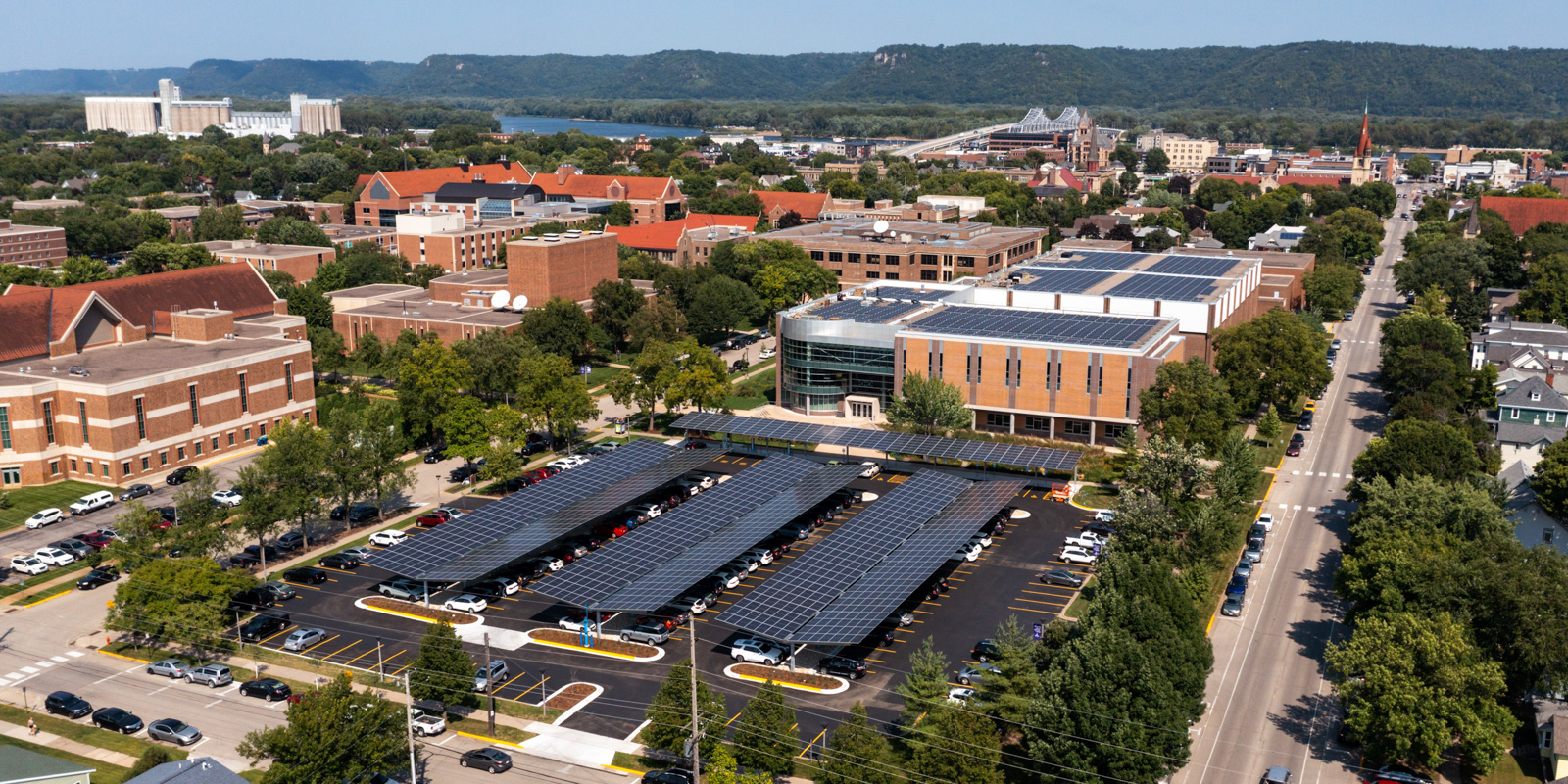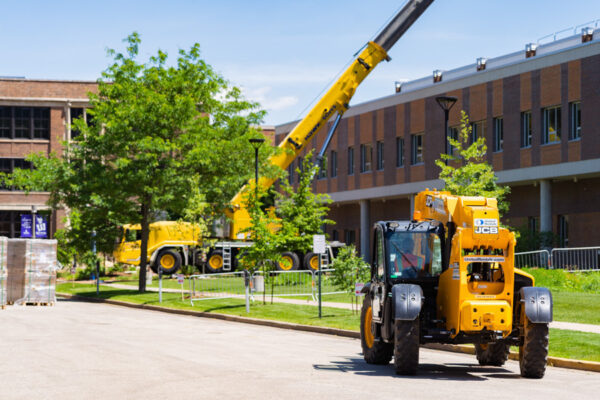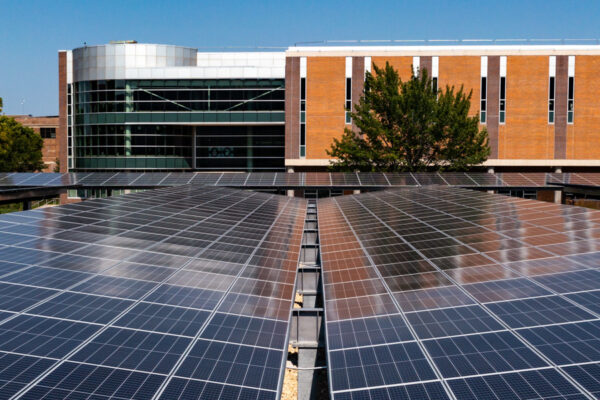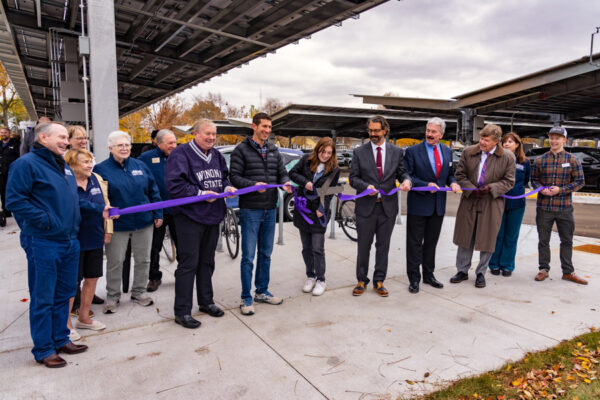
Leading Energy Savings & Sustainability
LESS is truly more with the Leading Energy Savings & Sustainability initiative.
This project is part of what makes WSU the most energy efficient university in the Minnesota State System.
WSU successfully implemented a $12 million campus-wide paid from savings energy conservation project that:
- dramatically improves campus energy and water efficiency
- addressed $7.5 million in deferred maintenance
- reduces WSU’s environmental impact
- improves educational experiences
- increases comfort and improves aesthetics
- will save $26 million over the project’s lifetime
This project also features the largest solar energy system on any Minnesota State campus.
It also reduces maintenance expenditures with $26 million cumulative savings anticipated over the 25-year project lifespan.

This project made significant changes that affect nearly every part of campus. The profound impact is due to these renovations.
Over 20,000 light fixtures were upgraded with more efficient LED technology and advanced controls.
The solar panels located on 6 rooftops and 4 carports will produce enough electricity to power 170 average homes a year.
The project replaced every toilet, shower head, urinal, and faucet aerator with modern water saving fixtures.
Our new irrigation system uses smart controls that will adjust sprinklers by using real time weather data to calibrate irrigation cycles based on past, current, and forecasted precipitation.
There are also 6 rooftop solar PV installations at Haake Hall, Helble Hall, Integrated Wellness Center, Kirkland Hall, McCown Gym and Wabasha Recreation Center.
These solar panels provide:
- 1.4 MW total solar PV capacity
- Combined solar PV systems will produce 1,694,845 kWh of renewable energy per year
- 9.6% of WSU’s annual electricity consumption will be met by on-site solar PV

Energy & Water Savings
4,975,121 kWh per year
225,809 Therms per year
9,816,000 Gallons per year
It improves finances, learning opportunities, and even community job opportunities.
- Largest Guaranteed Energy Savings Program project in the 9-year history of the program
- Largest Minnesota State campus solar project at 1.4 MW
- First rooftop solar variance on a Minnesota State campus
- Makes WSU the most efficient Minnesota State university on a cost/square foot basis
- Construction provides jobs that contribute money back to the community, with preference toward hiring construction businesses owned by women, veterans, and people of minority populations
- Solar provides interdisciplinary learning opportunities

Project financed on a paid-from-savings basis through a lease purchase agreement. These annual lease payments are structured to be less than the annual guaranteed savings.
There is no cash down for WSU. Plus, the project contractor guarantees annual savings and is responsible for any shortfall— meaning there is no risk to WSU.
The self-funding timeframe is 18 years, and all savings go to WSU after this point.
Highlights
- Impacts all main campus buildings and grounds
- Dramatic before and after impacts
- Standardization of lighting color temperatures across campus
- Lighting levels were adjusted to consistently match industry standards
Over 20,000 building, pathway, and parking lot lights campus-wide were converted to high efficiency, long-lasting LED technology.
This upgrade represents a significant energy and carbon reduction opportunity and is focused on maximizing energy efficiency, improving occupant comfort and aesthetics, and reducing maintenance burdens.
Key Outcomes
- Reduces energy use
- Addressed deferred maintenance
- Reduces ongoing maintenance needs
- Reduces carbon and other emissions
- Improved comfort and aesthetics of spaces
- Saves money
Highlights
- Impacts six building rooftops and the IWC parking lot
- IWC carports are the most iconic visual component of the project
- Introduced solar PV technology to the WSU campus in a big way
This project constructed 1,403 kW-DC (1.4 MW) of solar energy through six rooftop arrays and four carports. As a result, 9.6% of WSU’s annual electricity consumption will be met by on-site solar PV.
PV materials and devices convert sunlight into clean, renewable, carbon free electrical energy.
| Location | kW Output (DC) |
| Haake Hall Rooftop | 34.4 kW |
| Kirkland Hall Rooftop | 34.4 kW |
| McCown Gym Rooftop | 316.7 kW |
| Integrated Wellness Center Rooftop | 206.6 kW |
| IWC Parking Lot (Carport) | 577.1 kW |
| Helble Hall Rooftop | 151 kW |
| Wabasha Rec Center Rooftop | 83 kW |
| Total | 1,403 kW (DC) |
Key Outcomes
- Reduces energy use
- Reduces carbon and other emissions
- Saves money
- Provides enhanced educational opportunities
- Positions WSU as a leader in the Minnesota State System
Highlights
- Impacts 24 main campus buildings
- Replaced every toilet, shower head, urinal, and faucet aerator with modern water saving fixtures
This project upgraded hundreds of fixtures with modern, high-performance, ultra-low flow fixtures to generate maximum water and energy savings while simultaneously meeting user performance and comfort expectations.
Key Outcomes
- Reduces water use
- Addressed deferred maintenance
- Reduces ongoing maintenance needs
- Reduces carbon and other emissions
- Saves money
Highlights
- Impacts all campus buildings
- Improved system performance will result in more comfortable classrooms, meeting spaces and offices
HVAC and major mechanical equipment throughout campus are controlled primarily through a Building Automation System (BAS).
This upgrade provides enhanced alignment of the multiple control system types and vintages present on campus by updating BAS graphics and programming as well as by expanding the capabilities of the system to track real time building conditions.
This will drive maximum efficiency of controlled systems and increase system performance.
Key Outcomes
- Reduces energy use
- Addressed deferred maintenance
- Reduces ongoing maintenance needs
- Reduces carbon and other emissions
- Improves comfort of spaces
- Saves money
Highlights
- Impacts irrigation systems serving all areas of main campus
- Improved system performance so that watering will be reduced overall and conducted only when necessary
Irrigation controllers have been upgraded throughout campus.
Upgraded smart controllers will detect soil moisture content and actual and predicted rainfall amounts to adjust sprinkler usage and eliminate excess water consumption through over-watering.
Plant types are programmed into the controllers to provide customized watering rates, thereby driving additional savings.
Key Outcomes
- Reduces water use
- Addressed deferred maintenance
- Reduces ongoing maintenance needs
- Saves money
Highlights
- Impacts 24 buildings and the underground utility tunnels
Steam, heating hot water, domestic hot water, chilled water, and condensate piping are present throughout campus.
Proper insulation is critical to ensuring that heat transfer is minimized as working fluids are distributed throughout campus and within each building.
Heat transfer through uninsulated or poorly insulated piping represents a constant waste of energy.
This project covered thousands of feet piping that had missing or damaged insulation with new insulation that meets or exceeds energy code.
Additional areas that were left uninsulated after original building construction due to cost concerns were insulated as part of this project.
Key Outcomes
- Reduces energy use
- Addressed deferred maintenance
- Reduces carbon and other emissions
- Saves money
Highlights
- Impacts the Memorial Pool
- Less harsh chemical treatment improves experience for swimmers
- No longer need to store and use large amounts of hazardous chemicals
This project replaced the previous inefficient system with a new highly efficient control system with real time monitoring of pool chemistry, filter condition, temperature level, and occupancy.
A Variable Frequency Drive (VFD) changes pump speeds to meet required water changes while reducing energy consumption.
The chemical treatment system was upgraded with an on-site sodium hypochlorite generating system. Sodium hypochlorite generators produce pool chlorination chemicals from the electrochemical reaction between salt, water, and electricity.
On-site production of chlorine as a solution of sodium hypochlorite alleviates the risks to public health and safety relating to the storage and transportation of hazardous acid and concentrated chlorine solutions.
The only raw material, salt, is an inert, safe compound that is stored in a feeder on-site and used as required by the chlorine generator.
Key Outcomes
- Reduces energy use
- Reduces water use
- Addressed deferred maintenance
- Reduces ongoing maintenance needs
- Reduces carbon and other emissions
- Improves comfort and safety of spaces
- Saves money
Highlights
- Impacts 17 buildings
- Small upgrades will lead to major savings
Gaps and improper sealing of building exteriors can lead to excessive air leakage, which results in increased energy costs and the potential for airborne contaminants and odors to enter buildings.
Building weatherproofing improvement opportunities were identified in several buildings.
The primary focus of these opportunities were exterior door weather-stripping as well as window caulking.
These weatherproofing measures will prevent air movement and reduce energy costs associated with heating, cooling, and ventilating.
Key Outcomes
- Reduces energy use
- Addressed deferred maintenance
- Reduces ongoing maintenance needs
- Reduces carbon and other emissions
- Improves comfort of spaces
- Saves money
Highlights
- Impacts the three diesel generators used to provide backup electricity for the main campus
Three diesel generators provide backup electricity for the main campus. The generators require engine block heaters to operate continuously to provide immediate start capability under cold weather conditions.
Inefficient electric resistance heaters were previously used to keep the engine blocks warm. These are now supplemented by high efficiency heat pumps connected to each generator to serve as the primary heating source.
This allows the engine block heaters to operate using less energy and at a lower operating cost to the University.
Key Outcomes
- Reduces energy use
- Reduces ongoing maintenance needs
- Reduces carbon and other emissions
- Saves money
Highlights
- Impacts McCown Gym, Gymnastics Gym, IWC Gym, and the IWC cardio fitness area
- The fans are noticeable, but high up and not in typical plan view
Interior spaces with high ceilings are subject to air stratification which results in temperature differentials of up to 20°F between the floor and ceiling.
During winter months this causes accelerated heat transfer through the building roof resulting in increased heating demand and reduced occupant comfort.
Installation of destratification fans equalizes temperature throughout the spaces and reduces unnecessary heat loss.
Fans were installed within several feet of the ceiling in each space to distribute warm air back down to occupied areas.
Fan height, distribution, and speed are designed to prevent noticeable drafts by occupants. Integrated control systems only operate fans when detrimental stratification is detected.
Key Outcomes
- Reduces energy use
- Reduces carbon and other emissions
- Improves comfort of spaces
- Saves money